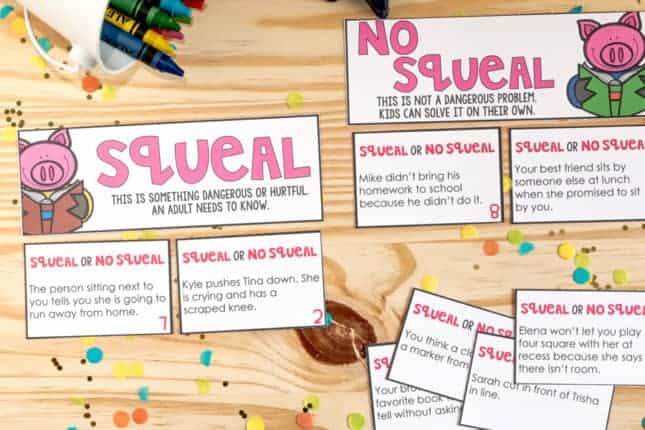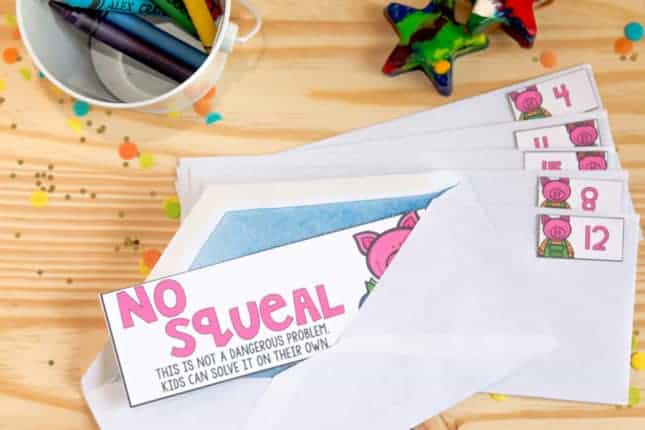How to stop tattling with one easy lesson
Tired of listening to students tattle on one another? Wish your students knew the right situations to report concerns but are not sure how to stop tattling in your classroom? Social Skills through Literature: Tattling vs. Reporting is perfect for helping students distinguish the difference between tattling and telling. This resource is ideal for setting expectations for the new school year or as a mid-year review when issues arise.

Heads up: I’ve included affiliate links with this post. If you click them, your items won’t cost any more, but I will earn a small commission.)
What’s Included in this Tattling vs. Reporting Lesson?
Social Skills through Literature: Tattling vs. Reporting has everything you need to teach a social skills lesson lesson that will reduce tattling in your classroom. The core components of the pack are:
- Step-by step cross-curricular lesson plan using Don’t Squeal Unless it’s a Big Deal
- Sequencing foldable for story retell
- Student reflection sheet
- Squeal or No Squeal game
- 16 scenario cards (plus 8 bonus cards focusing on digital citizenship)
- 2 classroom anchor charts
Implementing this Lesson Plan to Stop Tattling in Your Classroom
These activities are easy to add to your routine during your reading or writing time. They are student friendly and engaging, while helping build a unified understanding of the differences between tattling and telling.
Tattling vs. Reporting: The Reading Component
The read aloud used in this lesson is Don’t Squeal Unless It’s a Big Deal. The story covers the differences between telling and reporting using some super cute pigs who love to tell on one another. The story is really approachable and if you have multiple copies, you can even put students into small groups to read it together rather than using it as a read aloud.
The focus of the reading portion of this lesson is around sequencing and retelling.
Students listen to the story and complete a foldable organizer to retell the main events of the story. This is great for listening comprehension, and it is perfect for a gradual release model with this skill.
The foldable is easy to create. Students fold on the solid line and cut the dotted lines to create 4 flaps. They then write a sentence under each flap to retell the story.

You can write the retell sentences together as a class. You could also use this foldable in partners or have students work independently, depending on your class.
I typically also allow students to sketch an illustration to go with each sentence on the other side of the flap.
Tattling vs. Reporting: The Writing Component
This lesson includes a student reflection sheet. The reflection sheet requires students to connect the story with their personal experiences. With space to add an illustration, this is a fun and easy way to evaluate student understanding of the differences between tattling and reporting.
Help reluctant writers get started by brainstorming ideas as a class. I’ve also had students partner up or work in small groups to share experiences before they started their reflection. This opportunity to activate background knowledge is great for all students, but it really helps those kids who typically struggle with getting started.
It also makes a great bulletin board for a visual reminder for students.

A Game or Center Activity
Games are a great way to help reinforce your lesson and reduce tattling in the classroom. To spark conversation and really make sure that students understand the differences between tattling and telling, a game is included with this lesson. The game is called Squeal or No Squeal. It asks students to analyze scenarios to determine whether they should tell.
There are multiple options for how to play this game. Directions are provided for each method for implementation. Some teachers perfer to put students into small groups to sort the scenarios into two categories – Squeal or No Squeal.

Other teachers implement the more exciting game format by using envelopes to create a game similar to Deal or No Deal. This requires a little more preparation, but it is a really fun game to play as a class. In fact, it is so fun students often forget they are covering an important social skills topic.

Regarless of how you use the scenario cards included with this lesson, you’ll generate some great discussions and students will have a chance to develop a deep understanding of what your classroom expectations are.
I’ve updated this resource to include a set of scenarios related to technology. More issues are arising involving the use of technology to bully or make inappropriate choices these days. These cards are designed to help foster a discussion about digital citizenship.
Tattling vs. Telling Anchor Charts or Classroom Posters
There are also two posters included wtih this pack. Use the posters as anchor charts in your classroom for a visual reminder of the lesson. They are designed to be bright and colorful. They also include the pigs as a visual cue to remind students what they learned in the story.
The first poster reviews the differences between telling and tattling. This is great for referring to when students approach with a tattle. The easy to read table is designed to be easy to understand.

The second poster is meant to help students solve “kid-sized” problems. These are the problems that shouldn’t need an adult to solve them. The poster outlines the steps students can take to try to solve the problem independently before seeking out a grown-up’s help. However, it does include a final step of getting an adult involved if things can’t be resolved…because students sometimes forget that is an option until the disagreement has reached a boiling point.

Why this tattling lesson helps your students
This lesson gives learners chance to consider a number of scenarios that they may experience during the school year. Students begin to see patterns and better understand situations where they should report.
It also gives students the adult support they need to navigate tricky situations and helps them identify how a teacher might help them and when they might be asked to work the problem out with their peers.
Because students are still working on important literacy and writing skills, this lesson is ideal for classrooms where students need consistent reinforcement of both social and academic skills.
How to purchase Social Skills through Literature: Tattling vs. Reporting
I hope you like all the updates I’ve made to this important lesson. Social Skills through Literature: Tattling vs. Reporting is available on Teachers Pay Teachers.
Teaching social skills can be challenging with all the academic requirements. However, when we devote time to teaching kids our expectations, the rewards are many. I hope this article helps you “stop the tattle” in your classroom.







